Today i’m stuck in Turin, it’s been snowing all day long. I’m not complaining but i don’t feel like venturing outside to see exhibitions so i’m going to point you to an online exhibition over at dARTboard, a digital art space that the Vilcek Foundation created to ‘celebrate the accomplishments of foreign-born artists living in the United States and working in the realm of digital art.’ This year’s featured artist is Marc Böhlen who’s showing two works that investigate the relationship between people and automated systems.
The first work is WaterBar, an installation that geoengineers water in response to news on global water crises. The liquid is first filtered to be perfectly clean and then remineralized using a filter bank which releases traces of magnesium, iron, calcium and other elements in proportion to the intensity of related problems found in pertinent realtime online news.
The minerals delivered are connected to a number of locations and symbolic significations. For example, increased readings on water conflicts caused by greedy corporations are countered by adding more of the water mineralized with sandstone from La Verna, Italy, where St. Francis cared for the poor. Similarly, increased readings on topics suggesting over confidence in technology, is counterbalanced by adding more water mineralized with quartz-rich granite from Inada by Fukushima, home of the latest devastating high-tech catastrophe. The result is a unique water mix that acts as an ‘antidote’ to the news of the day.
Marc Böhlen, Waterbar
The second work, MakeLanguage – SyntheticAccents, attempts to overcome the shortcomings of commercial text-to-speech (or TTS) systems which only offer standardized, idealized speeches devoid of any slur or strong accent.
MakeLanguage – SyntheticAccents creates accented Englisch (Frenglisch, Genglisch and Spanglisch accents in limited vocabularies) to speculate upon the imagined lives of these accents without origins.
To be honest, i wasn’t particularly impressed by Volcek’s “electronic art space” because i can’t see how a couple of webpage that reproduce some of the content of the artist’s website can be regarded as an online exhibition. I was expecting more curatorial weight, effort, and inventiveness. That said, i’m not only impressed by the Foundation’s general aims and missions but i also welcomed the news of this online show as it allowed me to catch up with Marc Böhlen, an artist-engineer whose work i’ve been admiring almost ever since i started this blog.
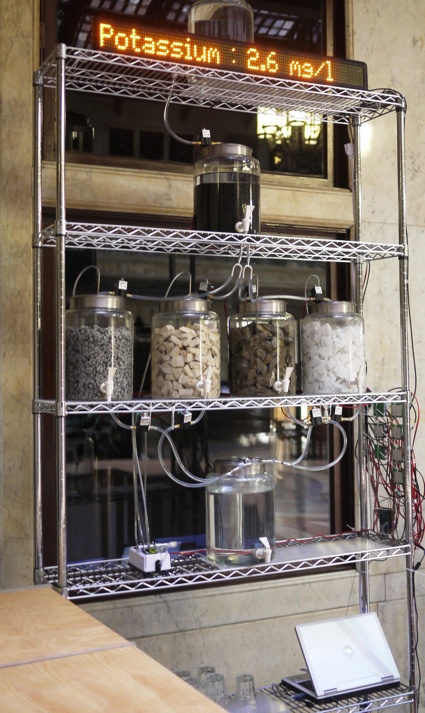
Extracts of our online interview:
Hi Marc! Let’s start with WaterBar. The installation is a ‘water-well designed for the post-sustainability age when clean water is simply not good enough.’ Can you explain what you mean by post-sustainability age? Is this when we realize that achieving sustainability is impossible? Or when we go to extreme lengths in order to obtain what we regard as ‘sustainable’?
WaterBar is inspired by two different and related ideas.
The first idea is part of an ongoing inquiry into informatics as a way to re-invigorate the public realm and the commons. My interest in this endeavor is the coupling between material processes and information flows. I want to find niches where this exchange can be powerfully experienced. Water management (which should be called water care) is one such arena. Water quality, water quantity, water ownership. The water problem concerns everyone, everywhere.
The second idea is the current fixation on the ‘sustainability’ model. No doubt, sustainability is of paramount importance in the near and midterm. But one day, we will have solved the sustainability challenge (provided planet earth still exits). And then what? What kind of relationship can we build with resources beyond risk management and damage control?
I just showed WaterBar for one month in Singapore, where industrial level water management delivers clean (as in not risky) water to the entire island. Even waste water is recycled and returned to the drinking water system. The water cycle is complete. From a sustainability perspective, the problem is ‘solved’. Interestingly, the exact proportion and timing of the release of this processed water (coined ‘new’ water) into the public drinking water system is a state secret; details are withheld from the public. The researchers at the Aquatic Science Center I consulted claimed that people simply do not want to know this because of the unresolved relationship to dirty water in general. Similar responses have been reported in San Diego (USA) where a novel waste water processing plant delivers ‘clean’ drinking water. In short, the water problem is not just a technical, not just a political problem. It is a problem of a ‘failed’ relationship between people and technology. It is a civilization challenge. Up to now, good water was equated with fresh water. But there is not enough fresh clean water to serve everyone on the planet. The future will require new approaches to this problem. That is one reason geo-engineering is so important. These are the aspects of sustainability WaterBar responds to.
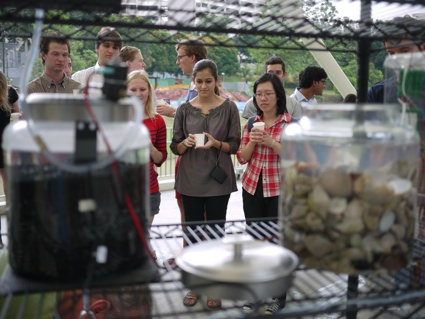 Aquatic Science Center, Singapore, 2012
Aquatic Science Center, Singapore, 2012
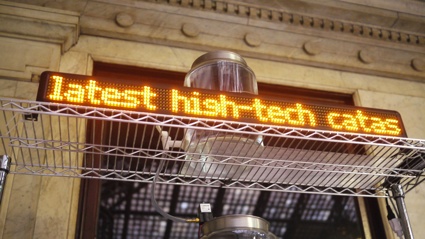 To me, WaterBar sounds a bit like a satire of the fashion for food that will ‘heal’ us more than feed us, for the new ‘superfoods’ that keeps being praised in the health pages of newspapers. But of course i might be completely wrong so what motivated this desire to ‘improve’ the water we drink?
To me, WaterBar sounds a bit like a satire of the fashion for food that will ‘heal’ us more than feed us, for the new ‘superfoods’ that keeps being praised in the health pages of newspapers. But of course i might be completely wrong so what motivated this desire to ‘improve’ the water we drink?
Well, there is a component of satire, but not in the installation. The WaterBar installation really does produce mineralized water. It adds iron, calcium, magnesium and other minerals in minute but detectable levels.
The satire is in the shelves of supermarkets and restaurants that sell mineral water to health-fashion victims. The improvement, as it were, that WaterBar offers is an improved relationship to water, to the water mix of the day as it is influenced by current water problems occurring all over the world.
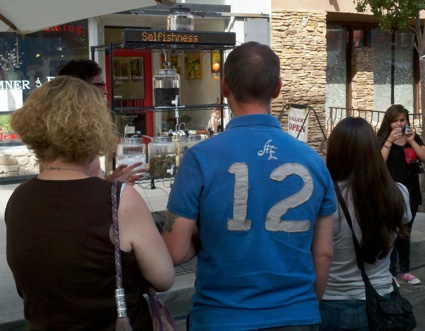 ISEA, Albuquerque, 2012
ISEA, Albuquerque, 2012
The remineralized water is offered for public consumption. Are people eager to test them? Do they taste very different from each other?
WaterBar searches the internet for news on water problems that concern everyone. WaterBar makes in response to this collection of information (usually bad news!) by passing water from its reservoir through the filter banks and mixing it to a ‘catch of the day’.
The relationship between the filter banks (of collected rocks and minerals from different parts of the planet) and the news feeds is based on an oppositional mapping scheme. For example, the Inada Granite filtered water is added to the mix when the system finds instances of ‘overconfidence in technology’. (This Inada Granite was sourced from a quarry south of Fukushima, home of the latest high tech meets natural resources catastrophe). Anyway, depending on the mix, the water tastes different. You can’t taste all the variations – at least I cannot – and it usually has a bit of chalky taste due to the choice of limestone and marble in the filter banks. Some people really enjoy it.
In order to ‘mineralize’ the water one has to expose the water to the filter materials for a certain time. At about 30C it takes only about 5 hours or so for the filters I have chosen to reach close to saturation level. At colder temperatures it can take longer. I usually fill up the filters 24hrs in advance and refill overnight.
Yes, the mixes are always different, as different as the news feeds describing water problems. News feed change all the time, but luckily water catastrophes have a slower update rate! This is an interesting problem – how do you relate temporal flows of information systems to the temporal flows of geological systems. Anyway, some mixes taste very different from others, some seem hardly different. The variations in chemical properties are far greater than the resultant variation in tastes.
Some people were very eager to taste the water. During the first show in Buffalo, NY, one fellow stopped by the WaterBar every day. At the end of the week, he stopped by with a large canister to get WaterBar water for his cats and plants!
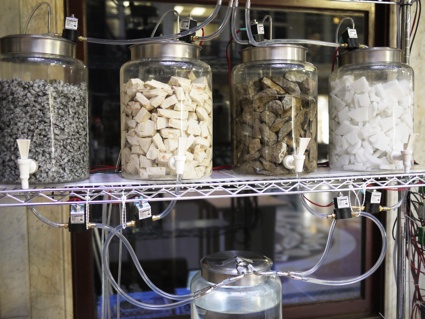 Buffalo, New York, 2011
Buffalo, New York, 2011
Can you also explain us the ‘internet-scanning, text-processing control system”? What does the system scan exactly? And how does its search influence the final mixing/mineralizing of the water?
WaterBar’s software contains a module that checks a large list of websites on water resources, including, waterworld.com, circleofblue.org, ecology.com, mondediplo.com and many others. Depending on where WaterBar is operating, I add sites with locally pertinent information. The internet-scanning algorithm checks these sites, dissects the content and maps it onto an ‘association matrix’ that relates the origins of the filter banks to the web search results. This is where information directly becomes material. I use the simple ‘bag of words’ approach. For example, the Inada filter (see above) bag of words contains the concept attributes: ‘hazard’, ‘hightech’, ‘disaster’, ‘nuclear’, ‘contingency’, ’emergency’, ‘highrisk’, ‘failure’, ‘advanced technology’ (with spelling variations). The algorithm creates a normalized distribution map based on frequency of occurrences for all the filter banks and concept attributes. This does not produce an exact representation of the information flow relevant to the filter topic. But the error rate is uniform across all the filters. From an engineering perspective this is not really good enough, and certainly needs some more attention. But even if I spend the next five years perfecting this, there will always be a difference between what I can capture, what is flowing in the internet and what actually happens in the world. I see the current approach more like a fishing expedition.
The catch of the day are fish that were actually in the water at the time you went fishing, but the fish you catch do not necessarily represent all the fish in the ocean. Anyway, the result from the internet scanning algorithm might suggest this kind of distribution: 20% filterA, 35% filterB, 15%filterC and 30%filterD. A second algorithm creates a water mix in this proportion by opening and closing the electronic valves that connect the filter banks to the bottom jar. A third algorithm calculates the effective chemical composition of the resultant water (based on the mix ratios and measurements of the water in the filter banks). E mg/L of iron, F mg/L of calcium, and so on. Just like the descriptions on commercial mineral water bottles. This info is scrolled on the large LED screen at the top of WaterBar. Gravity is the only force moving the water from the top to the bottom.
“MakeLanguage – Synthetic Accents creates accented English to speculate upon the imagined lives of these accents without origins.” Listening to these accented TTS, i was immediately transported to place i had been. Accents come with personality and emotions. If i could pick up the accent of my GPS i would be delighted. I’d certainly go for the lovely accent that people from Flanders have when they speak french. How do people react to accented TTS?
My experience has been that people find these accents mostly humorous. I don’t know why! To me they are vehicles of ‘Entfremdung‘. They sound like humans with a life history but are fake!
To me the weird experience hearing these voices is not unlike the ‘uncanny valley’ effect coined in robotics that describes the effect of experiencing an almost living/human thing and then all of a sudden realizing that what was thought to be alive is inert (technology). The fall from the initial attraction is augmented by the degree of veracity of the effect. I don’t think we have culturally come to terms yet with machines that really sound like we do. Not only because of this direct audible disjoint, but because of the subsequent intuitive step of assuming that what sounds human must be human. Maybe this is as disruptive a step as the introduction of the telephone that undid the notion of presence and voice. Prior to the popularization of the telephone, presence was coincidental with physical proximity. The advent of the telephone changed that, and a ‘live’ voice could be heard from faraway. It took some time before people could grasp this in daily life.
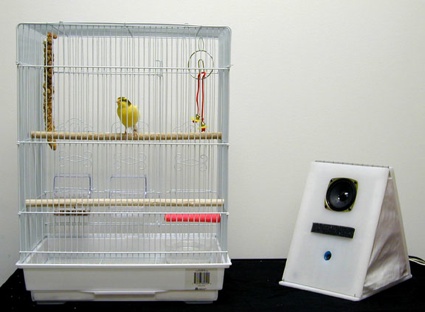 Marc Böhlen with JT Rinker, U.W.M., 2003 – 2005
Marc Böhlen with JT Rinker, U.W.M., 2003 – 2005
Now this might be a naive and silly question but how did you record these heavy accented sentences? Did you ask a german-speaking person to speak like a computer? Or did you tweak the TTS system instead?
The accented utterances are 100% synthetic! They have never been uttered by a living person, and can be generated on the fly by the system.
Just a few short comments for context. MakeLanguage – Synthetic Accents was the work I did after the Universal Whistling Machines project. That work considered the utopia of a communication system that would combine machines, people and animals. Anyway, after the foray into whistles I became fascinated with text to speech systems that use advanced signal processing to produce utterances that mimic human voices.
Synthetic speech systems use various approaches, but one popular one is based on the unit selection principle by which elementary units of speech (phonemes and diphones) are combined based on language specific rules to larger units such as word and phrases. One starts with a collection of sound bites (a corpus of utterances) made by a specific human being, recorded in a studio. Synthetic speech engineers refer to people whose voices are used as ‘voice talent’. Anyway, these utterances are then dissected, rearranged and ‘atomized’ to elements that can be recombined ad lib, usually in the language model of the native speaker. Whatever such a synthetic voice says will sound as if the original human being said it. Anyway.
Back in 2005 I approached a startup company (SVOX, no longer operating..) that had, in my view, an excellent synthetic speech engine and asked them if I might experiment with the system, promising ‘interesting results’. Luckily I received access to the software. It would have been almost impossible to do this project having to build all the software from scratch.
My very simple but effective approach was to selectively mix units of speech from one language with language models from another. This in itself did not produce good results, so I added some ‘accent rules’ to address the problem of intonation. Even that did not work well. I had to make lots of special rules, and the system got rather unwieldy. I was not able to create a general purpose accent generator (as I hoped for in wild dreams) but a system that would work with a few languages for limited vocabularies. One rather weird part was the testing. Who do you test on? How do you know when the fake accents sound ‘right’? So I concentrated on language mixes I am familiar with through my own history and background and tested the strange voices on myself. Once I was ok with the basic sounds, the question of content moved front and center. What should/could these voices say? Some very weird conversations between the voices and me ensued, as you might imagine. Amway, I ended up mostly in the service industry (hotels, airports) and played with the kind of phrases you hear in those impersonal settings. It felt so right in a very wrong way.
What does an exhibition on the online platform dARTboard, bring to your practice? Do you think that an online exhibition has as much strength as one in a brick and mortar museum? In terms of audience, recognition and also ability to engage with an artwork?
I do prefer brick and mortar for installations like WaterBar. I really do want people to drink the water. The installation has a powerful presence, I think. Video documentation is a compromised replacement. Plus you don’t get to see people’s reactions.
The synthetic voices from the MakeLanguage trilogy are a different matter. I don’t think they lose much by being online. Maybe that is the only place they can really be at home after all.
Thanks Marc!
Related: Interview of Marc Böhlen and When a machine picks a fight.
